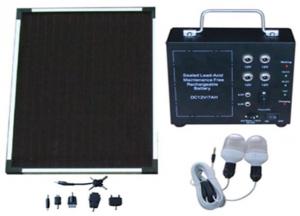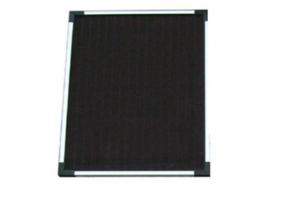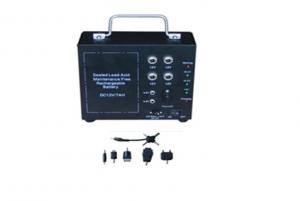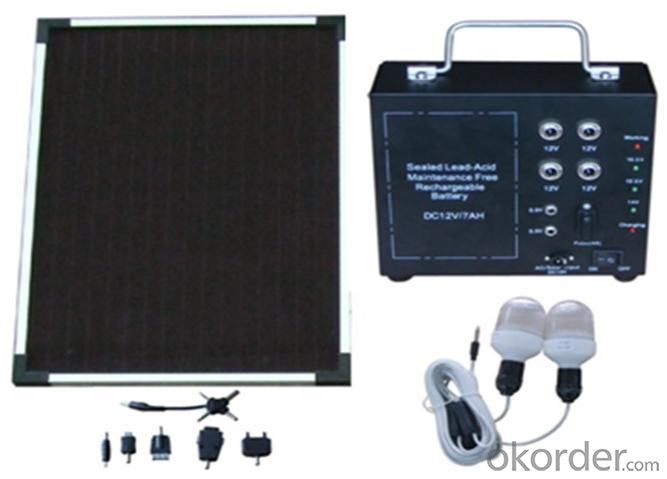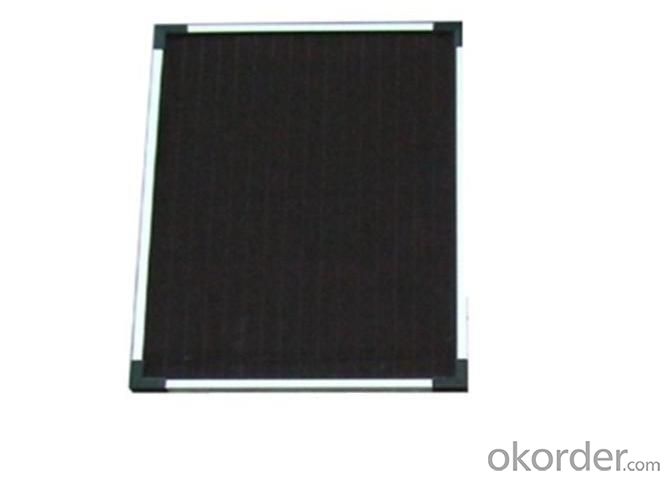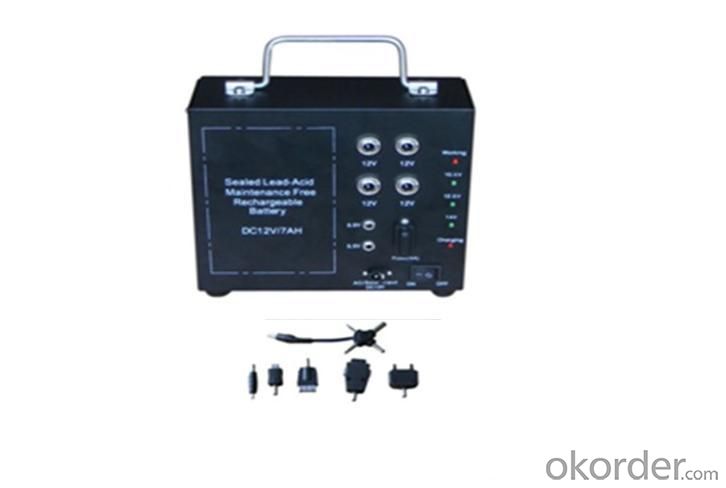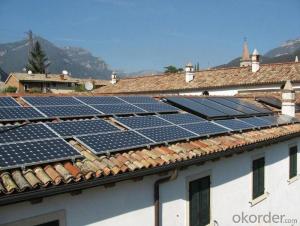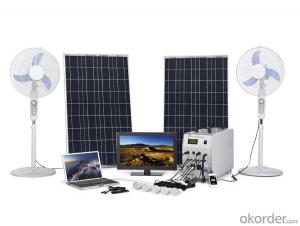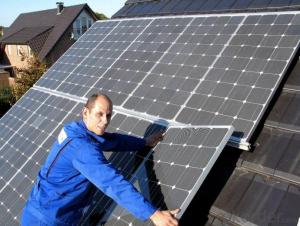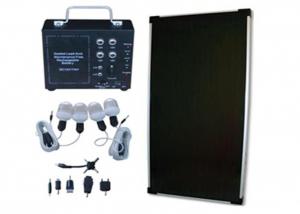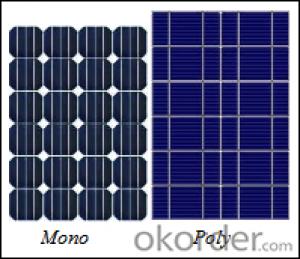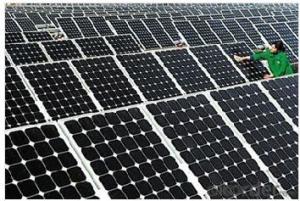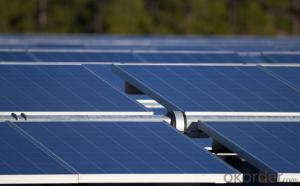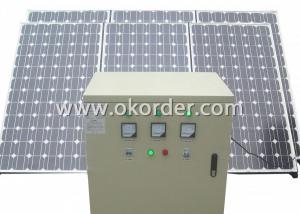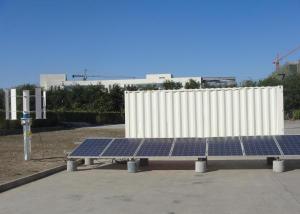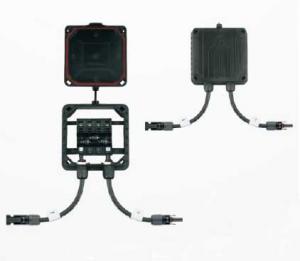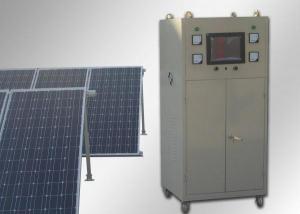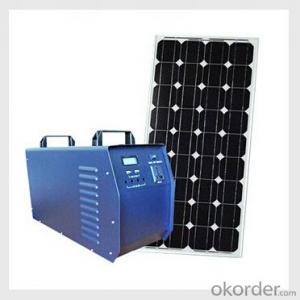Puerto Rico Solar Energy Systems CNBM-TS1 (5W)
- Loading Port:
- China Main Port
- Payment Terms:
- TT or L/C
- Min Order Qty:
- 1 set set
- Supply Capability:
- 1000 sets per month set/month
OKorder Service Pledge
OKorder Financial Service
You Might Also Like
Brief Introduction of Solar Energy System CNBM-TS1 (5W)
CNBM Solar Energy System is specialized in PV power 5W output, which takes advantage of reliable supplying, convenient installation and free maintenance, and has been used widely, and it is the compensation and substitution of normal power supply.
CNBM Solar panel offers high performance of power per square foot of solar array.Poly- or multicrystalline silicon(poly-Si or mc-Si): made from cast square ingots — large blocks of molten silicon carefully cooled and solidified.
The Sketching of Solar Energy System CNBM-TS1 (5W)
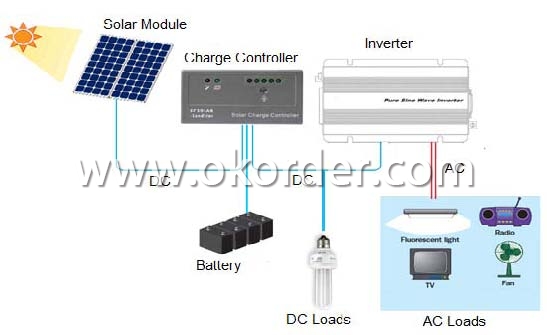
Components of Solar Energy System CNBM-TS1 (5W)
PV Array:
Convert sunlight instantly into DC electric power. Formed by the solar modules (also called photovoltaic modules) in accordance with the system requirements for series and parallel.
Solar Charge Controller:
A charge controller may be used to power DC equipment with solar panels. The charge controller provides a regulated DC output and stores excess energy in a battery as well as monitoring the battery voltage to prevent over charge or over discharge. An inverter can be connected to the output of a charge controller to drive AC loads.
Inverter:
Converts DC output power of photovaltaic soalr panels into standard AC power for use in the local off-grid electrical network. It is a critical component in a photovoltaic system, allowing the use of ordinary commercial appliances.
Battery banks:
Stores energy when there is an excess coming in and distribute it back out when there is a demand. Solar PV panels continue to re-charge batteries each day to maintain battery charge.
Technical data of Solar Home System CNBM-TS1 (5W) | ||||
Solar panel | Pmax | 5W | ||
Vmp | 17.5V | |||
Imp | 0/29A | |||
Battery | Capacity | 12V/7AH | ||
Accessories | 5W Amorphous Solar panel*1 Power box *1 LED bulb with 10m wire*2 Mobile phone adapter*1 Mounting pad*1 | |||
Package Data of Solar Home system CNBM-TS1 (5W) | ||||
Carton Size (L*W*H mm) | Carton Weight(kg) | PCS/CTN | 20’(PCS) | 40’(PCS) |
766*228*405 | 17.7 | 2 | 790 | 1650 |
Factory Picture of Solar Energy System CNBM-TS1 (5W)

Package Picture2 of Solar Energy System CNBM-TS1 (5W)
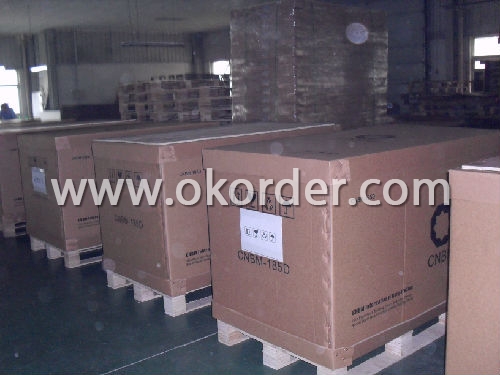
- Q: Can solar energy systems be used for powering RVs?
- Yes, solar energy systems can be used for powering RVs. Solar panels can be installed on the roof of an RV to harness sunlight and convert it into electricity. This renewable energy source can power various appliances and systems in an RV, reducing the dependence on traditional fuel sources and providing a sustainable and cost-effective solution for mobile power needs.
- Q: What are the financial benefits of installing a solar energy system?
- The financial benefits of installing a solar energy system include reduced electricity bills as solar power generates free electricity from sunlight, potential savings on energy costs in the long run, decreased reliance on grid power and utility companies, potential eligibility for government incentives and tax credits, increased property value, and the possibility of selling excess energy back to the grid for additional income.
- Q: What is the system voltage of solar panels
- Solar panels (Solar panel) is composed of one or more solar cells to form a solar panel. A solar cell is a semiconductor device that converts light into electrical properties, which can convert solar radiation energy on its surface into direct current
- Q: How does a PV system convert sunlight into electricity?
- A PV system, also known as a solar panel system, converts sunlight into electricity through the use of photovoltaic cells. These cells are made of semiconducting materials, typically silicon, which have the ability to convert sunlight directly into electricity. When sunlight hits the surface of the PV cells, it excites the electrons within the material, causing them to flow, creating an electric current. This current is then captured and harnessed by the system, allowing it to be used as electricity for various purposes.
- Q: What is the impact of saltwater exposure on solar panels?
- Solar panels can be significantly and detrimentally affected by exposure to saltwater. The presence of corrosive salts, particularly sodium chloride, in saltwater can corrode the materials utilized in solar panels. This corrosion can result in the deterioration of various components of the panel, including the frame, wiring, and connectors. The main concern with saltwater exposure is the potential damage to the protective coatings on the surface of the solar panels. These coatings are designed to shield the cells from environmental factors like moisture and UV radiation. When saltwater comes into contact with these coatings, it can break them down, exposing the solar cells. Once the cells are exposed, they become susceptible to the corrosive properties of saltwater. The corrosive salts can attack the metal contacts and connections within the solar panels, leading to a decrease in efficiency and overall performance. This corrosion can also cause electrical malfunctions, such as shorts or open circuits, rendering the solar panels completely non-functional. Additionally, saltwater exposure can result in the accumulation of salt deposits on the surface of the solar panels. These deposits can reduce the amount of sunlight reaching the cells, thereby decreasing their energy production. Furthermore, the salt deposits can create an additional barrier between the sunlight and the cells, further reducing efficiency. To mitigate the negative effects of saltwater exposure, it is crucial to implement appropriate maintenance and cleaning procedures for solar panels in coastal or saltwater-rich environments. Regular cleaning with a non-abrasive solution can help remove salt residues and prevent the buildup of deposits. Furthermore, utilizing corrosion-resistant materials like marine-grade aluminum or stainless steel for panel frames and connectors can help prolong the lifespan of solar panels in these harsh environments. In conclusion, saltwater exposure can be detrimental to the performance of solar panels, leading to corrosion, reduced efficiency, and potential system failure. Proper maintenance and the use of corrosion-resistant materials are crucial in minimizing the negative impact of saltwater exposure and ensuring the long-term effectiveness of solar panels in coastal or saltwater-rich areas.
- Q: What is the impact of roof orientation on the performance of solar panels?
- The efficiency and energy generation of solar panels are greatly affected by the orientation of the roof. The direction in which the roof faces, whether it be south, east, west, or north, plays a significant role. Solar panels perform best when installed on a south-facing roof as it allows them to receive the maximum amount of sunlight throughout the day. South-facing roofs receive direct sunlight for a longer duration, resulting in increased solar energy capture. If the roof faces east or west, the solar panels will still receive sunlight, but their energy generation may be reduced. East-facing roofs receive morning sunlight, which is advantageous in regions with higher morning electricity demand. However, energy production may be lower compared to south-facing roofs, as they do not receive sunlight for the entire day. Similarly, west-facing roofs receive afternoon sunlight, which may be beneficial in areas with higher afternoon electricity demand. North-facing roofs have the least favorable orientation for solar panels. They receive the least amount of direct sunlight, resulting in lower energy generation potential. In regions with predominantly northern orientation, solar panels may not be the most efficient or cost-effective solution for renewable energy generation. Aside from orientation, the tilt angle of the roof also impacts solar panel performance. The ideal tilt angle is typically determined based on the location's latitude. Adjusting the tilt angle can optimize sunlight exposure and maximize energy generation. To ensure optimal energy production and maximize the benefits of solar power, it is crucial to consider the orientation and tilt of the roof when installing solar panels. South-facing roofs offer the highest energy generation potential, while east, west, and north-facing roofs may have varying levels of efficiency.
- Q: Can solar energy systems be used in areas with high levels of poverty?
- Yes, solar energy systems can be used in areas with high levels of poverty. In fact, solar energy can play a crucial role in alleviating poverty and improving the living conditions of people in these areas. Here are a few reasons why solar energy systems are viable in poverty-stricken areas: 1. Cost-effectiveness: Solar energy systems have become increasingly affordable over the years, making them a viable option for economically disadvantaged communities. Once installed, solar panels can generate electricity without any recurring costs, reducing the burden on families struggling to pay for conventional energy sources. 2. Energy independence: Solar energy systems provide a decentralized and local source of electricity, allowing communities to become self-reliant and less dependent on the centralized power grids. This independence empowers people in poverty to access reliable electricity, improving their quality of life and enabling economic activities such as small-scale businesses. 3. Environmental sustainability: Solar energy is a clean and renewable source of power, which helps protect the environment in poverty-stricken areas. These regions often lack access to modern infrastructure, leading to a heavy reliance on fossil fuels, such as kerosene lamps or diesel generators, which contribute to pollution and health problems. Solar energy systems offer a sustainable alternative, reducing carbon emissions and improving air quality. 4. Job creation and economic development: The installation and maintenance of solar energy systems create employment opportunities within the local community. This job creation can stimulate economic growth and improve the financial prospects of individuals living in poverty. Moreover, solar energy can be harnessed for productive purposes, such as powering irrigation systems, small-scale manufacturing, or water purification, further contributing to poverty reduction. 5. Humanitarian aid initiatives: Various organizations and governments are actively involved in implementing solar energy projects in impoverished areas. These initiatives focus on providing solar power to schools, hospitals, and community centers, ensuring access to education, healthcare, and communication facilities. By addressing these basic needs, solar energy can uplift communities and enable them to break the cycle of poverty. In conclusion, solar energy systems have the potential to be used effectively in areas with high levels of poverty. The affordability, energy independence, environmental sustainability, job creation, and humanitarian aid aspects make solar energy an ideal solution for improving the lives of people living in poverty-stricken areas.
- Q: How does the efficiency of solar panels vary across different panel sizes?
- Solar panels can have varying efficiency across different sizes due to multiple factors. Typically, larger panels exhibit higher efficiency compared to smaller ones. This is primarily because larger panels possess a greater surface area for capturing sunlight, thereby enabling them to generate more electricity. Larger solar panels have the capacity to accommodate more solar cells, responsible for converting sunlight into electricity. These additional cells augment the overall power output of the panel, resulting in increased efficiency. Furthermore, larger panels often possess better current and voltage ratings, allowing them to produce more electricity even in low light conditions. However, it is important to note that the size of solar panels does not solely determine their efficiency. The overall quality and technology of the panel also play a significant role. Manufacturers may employ different levels of technological advancements, materials, and manufacturing processes, all of which can affect the efficiency of their panels. Moreover, external factors such as temperature, shading, and installation angle can influence the efficiency of solar panels. Higher temperatures can reduce their efficiency, while shading from trees or buildings can significantly hinder performance. Additionally, the installation angle of the panels can impact their exposure to sunlight, thereby affecting overall efficiency. In conclusion, while larger solar panels generally exhibit higher efficiency due to their larger surface area and increased power output, other factors such as panel quality, external conditions, and installation angle can also influence efficiency across different sizes. It is imperative to consider all these factors when selecting the appropriate panel size for a specific application to ensure optimal performance and energy generation.
- Q: What are the benefits of using solar energy?
- There are several benefits of using solar energy. Firstly, it is a renewable and sustainable source of energy, meaning it does not deplete natural resources. Secondly, solar energy helps reduce greenhouse gas emissions, contributing to a cleaner and healthier environment. Additionally, using solar energy can lead to significant cost savings on electricity bills, as it reduces dependence on traditional utility companies. Furthermore, solar panels require minimal maintenance and have a long lifespan, making it a reliable and durable energy solution. Lastly, solar energy promotes energy independence, as it allows individuals and communities to generate their own power, reducing reliance on external sources.
- Q: How do solar energy systems impact the reliability of electricity supply during blackouts?
- Solar energy systems can have a positive impact on the reliability of electricity supply during blackouts. With a properly installed solar energy system, homeowners and businesses can have access to electricity even when the grid goes down. This is because solar panels generate electricity from sunlight, which means they are not reliant on the traditional power grid. During the day, when the sun is shining, solar panels can produce electricity and power the electrical needs of a home or business. Any excess energy generated by the solar panels can be stored in batteries for later use. This stored energy can be utilized during the night or during power outages, providing a reliable source of electricity when the grid is down. Additionally, solar energy systems can be equipped with an inverter and a smart system that allows them to disconnect from the grid in the event of a blackout. This is known as islanding, where the solar panels continue to generate electricity for local consumption while isolating themselves from the main power grid. This feature ensures that solar-powered homes and businesses can continue to operate even when the grid is down. The reliability of solar energy systems during blackouts depends on the size and capacity of the system and the amount of energy stored in the batteries. Larger solar systems with ample battery storage can provide extended periods of electricity supply during blackouts, whereas smaller systems may only provide power for a limited time. It is important to note that the reliability of solar energy systems during blackouts also depends on maintenance and regular inspections. Ensuring that the solar panels, batteries, and other components are functioning properly will maximize their performance during power outages. Overall, solar energy systems can greatly enhance the reliability of electricity supply during blackouts. They provide a sustainable and independent source of electricity, reducing dependence on the grid and increasing resilience in the face of power disruptions.
Send your message to us
Puerto Rico Solar Energy Systems CNBM-TS1 (5W)
- Loading Port:
- China Main Port
- Payment Terms:
- TT or L/C
- Min Order Qty:
- 1 set set
- Supply Capability:
- 1000 sets per month set/month
OKorder Service Pledge
OKorder Financial Service
Similar products
Hot products
Hot Searches
Related keywords
